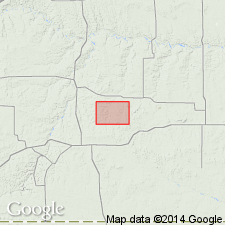
- Usage in publication:
-
- Thin Elk Formation
- Modifications:
-
- Named
- Dominant lithology:
-
- Sand
- Gravel
- Ash
- AAPG geologic province:
-
- Sioux uplift
- Chadron arch
Summary:
Named as the upper formation of Ogallala Group for exposures in Joe Thin Elk gravel pit, Millette Co, SD on the Sioux uplift. Type locality (also called type section) is in sec 35, T40N, R28W. Type area (geologic map) is in secs 25, 26, and 35, T40N, R28W. Composed of yellowish to brownish sand and gravel, usually unconsolidated, containing minor amounts of volcanic ash. Placers of garnet common. Cemented ledge-forming lenses locally near top. Blocks that weigh up to 50 kilos derived from underlying Rosebud Formation. Basal contact placed at point of change from yellowish sand and gravel of Thin Elk to pink silt of underlying Rosebud Formation. Occurs west of type to Pine Ridge and Devil Hill, south of White River, Shannon Co, SD on the Chadron arch. Overlies Rosebud Formation of Ogallala Group. Is a stream deposit that cut into Rosebud. Contains fossil vertebrates (insectivores, lagomorphs, carnivores, probascideans, perissodactyes, artiodactyls) (listed). Is of early Pliocene age.
Source: GNU records (USGS DDS-6; Denver GNULEX).
For more information, please contact Nancy Stamm, Geologic Names Committee Secretary.
Asterisk (*) indicates published by U.S. Geological Survey authors.
"No current usage" (†) implies that a name has been abandoned or has fallen into disuse. Former usage and, if known, replacement name given in parentheses ( ).
Slash (/) indicates name conflicts with nomenclatural guidelines (CSN, 1933; ACSN, 1961, 1970; NACSN, 1983, 2005, 2021). May be explained within brackets ([ ]).

